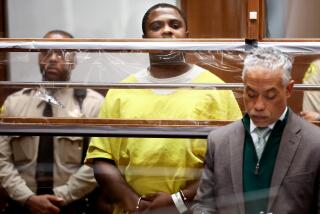One corner. Four killings. How a South LA neighborhood is moving forward
The first to die was her friend “Ken Dog.”
Five months later, her fiancé was gunned down, then another friend, “Bug” — all on the same South Los Angeles street corner.
Semaj Smith lives in Harvard Park, one of the city’s deadliest neighborhoods. Her yellow house is riddled with bullet holes. A dark stain from memorial candles marks the spot on the sidewalk where her fiancé died.
Across the street, in the park that bears the neighborhood name, children play baseball and climb on jungle gyms. A Bloods gang known as the Six Deuce Brims claims the park and nearby blocks, while the surrounding territory is controlled by Crips. A Crip looking for a Blood knows where to go. Sometimes, the victim turns out not to be a gang member.
Lately, the violence has escalated. Homicides in the half-mile or so around the park nearly tripled in 2016, to eight from three the year before.
So far this year, six people have been killed. Most of the victims were black men, though the neighborhood’s population of about 12,000 is roughly one-third black and two-thirds Latino. The area around Harvard Park was the deadliest place for African Americans in Los Angeles County last year, according to the Times’ Homicide Report.
There is no clear pattern to the recent killings. Rather, police and other experts say, such increases are not unusual in an area where the baseline level of violence is high, fueled by gangs, poverty and a readiness to settle arguments with guns.
The Crips-Bloods rivalry, which long has made Harvard Park a dangerous place, has not intensified lately or sparked a tide of retaliatory shootings, according to police. Some killings, like the 90-year-old man who shot his wife on Valentine’s Day, had nothing to do with gangs.
The southwest corner of the park, near Smith’s house at West 62nd Street and Harvard Boulevard, has been especially deadly. In the last year-and-a-half, four men have been killed there — while sitting in a car, trying to defuse an argument, walking home from the barber shop and the corner store.
Smith, 40, knew them all. Harvard Park is close-knit. People gather for impromptu barbecues. Her fiancé was not a gang member, nor were most of the other recent victims, police and relatives said.
Smith had planned to raise her children in the area, but she recently sent her 17-year-old son to live with his grandmother in Bellflower.
“You can’t say that you can get used to it or get over it,” she said. “You’re still surrounded by all the memories and all the years that you spend with the people.”
**
Driving north toward Harvard Park, Sgt. Chris Valento crossed Gage Avenue, the dividing line between 67 Crips and Six Deuce Brims territory.
In this part of South L.A., graffiti tells the story of shifting gang alliances and enmities. At the northern edge of the park, “FX13” — Florencia 13, a Latino gang — was scrawled on a wooden post. The Brims and nearby Crips are predominantly African American.
“That could kick off a feud — it’s disrespect to the 62 Brims,” said Valento, who works gangs for the Los Angeles Police Department’s 77th Division.
Valento pointed to the park bench, yards from a playground, where Patrick Caruthers was shot in 2012. Caruthers, 19, a longtime volunteer at the park who had overcome a learning disability to attend college, was not involved with the Brims. The shooter may have thought he was a gang member because of his burgundy-colored shorts, an LAPD detective said recently.
A poster seeking Caruthers’ killer still hangs from a bulletin board in the park. The case remains unsolved, despite a $50,000 reward.
“That was his crime. Sitting on a bench at Harvard Park got him killed,” Valento said.
Soon after Caruthers’ death, the city installed security cameras. The footage is fed directly to the police station, though the cameras mostly are trained on the park itself, not on nearby streets where many of the homicides have taken place. Young people often congregate in the only pocket of the park out of camera range. Recently, an anti-Crips epithet was scrawled on a wall there.
**
Even as the killings have increased, the park that anchors the neighborhood is a bright spot — with tennis courts, a swimming pool, a skate park, even golf lessons in the gym. Police officers coach youth sports teams. A summer day camp keeps kids occupied. Fewer gang members hang out.
But the threat of violence is never far. In June, two men sprayed gunfire near the playground about 7:30 p.m., while children were playing. No one was hit, but 10 shell casings were found at the scene, according to the LAPD.
Austin Dumas started work as the park director just before Caruthers was killed. He channeled his grief into his work, keeping kids busy with sports, field trips and jobs. He knew three of the four men killed recently on the park’s southwest corner.
Dumas, 37, said he fears for his life. People from the neighborhood know him. People from elsewhere could mistake him for a Brim.
“Our goal is to try to get home every night,” Dumas said.
In September, the LAPD launched a community policing program in the neighborhood. A team of officers will get to know residents and develop new sports and mentoring programs. LAPD officials credit the strategy for a three-year stretch without a homicide in the Jordan Downs housing development in Watts — and for making people less fearful of cooperating with detectives.
But mistrust of law enforcement runs deep in Harvard Park. Some residents fear that police officers will pretend to be allies, then turn around and arrest them. They wonder why detectives do not solve more homicides when the park is ringed with security cameras.
“They don’t care,” Earl Carter, a Harvard Park gang intervention worker, said of the police. “They’re trying to say we’re the bad people, but we’re always the victims.”
Carter said he joined the 62 Brims when he was 14. After several stints behind bars for battery and drug crimes, he decided to shape up. His first job in the mainstream economy, at age 27, was at a hamburger stand.
“I never looked at it like a gang,” said Carter, 49. “It was like a family. My brother, my sisters, everyone else I knew was in it.”
**
As teenagers played softball nearby, Carter and Andre Vickers, who also works to turn gang members’ lives around, gave a macabre tour of the deadly corner.
Brandon Tatum, known for riding his skateboard everywhere, was shot near that gray van, they said. Dewayne “Bug” Parham Jr. died by that stop sign. The sprawling stain marks where Smith’s fiancé, Abrey Tony White, took his last breath.
The bloodshed began with Kenneth “Ken Dog” Durden’s death last year.
Durden, 50, was a Six Deuce Brims “original gangster” known in the neighborhood for his generosity. After his 8-year-old son died in a drive-by shooting in 2003, he was never the same, said his wife, Beverly Johnson-Durden.
On Feb. 23, 2016, Durden was sitting in his gold Cadillac when a man fired into the car multiple times.
Detectives initially thought the killing was related to his gang ties. They now believe it may have stemmed from a domestic dispute involving an ex-girlfriend.
On the Fourth of July, White was fatally shot while walking home from the barbershop. Smith saw him fall to the ground. As his life ebbed away, she begged him to get up.
The 33-year-old, who had epilepsy and a slight speech impediment, had worked with his stepfather as an air filtration technician and forklift driver.
Parham was a pallbearer at White’s funeral. Four weeks later, he too lost his life on the deadly corner after trying to mediate an argument between two men at a barbecue.
One of the men shot the 42-year-old father of six, who had just started a new job at a film company and was known for expertly manning the grill at cookouts.
Smith, who was hosting the barbecue, called 911, screaming into the phone that her friend was still breathing.
She also knew the shooter, Curtis Ray Weaver, who was her ex-boyfriend. She testified at his trial, even after he and two others were charged with witness intimidation. He was found guilty and sentenced to 50 years to life in prison.
Tatum, 23, who worked at Wal-Mart and was training to become a cashier, was the next victim. On Jan. 11, he was on his way home from the corner store when someone began shooting at him.
He had talked of moving to Las Vegas, Arizona or the Moreno Valley. He didn’t feel safe in the neighborhood, he told his girlfriend, Kyrah Henderson.
“He just wanted better,” said Henderson, 20. “He felt like death was getting closer and closer to him.”
White and Tatum were not gang members, and it is not clear why they were targeted, other than being in Harvard Park, police and relatives said.
The Durden and White cases remain unsolved. An 19-year-old Crip from outside the neighborhood has been charged with Tatum’s killing.
**
At Smith’s house, her brother-in-law, Ernest Winters, pointed to bullet holes in the front door, in the rain gutter, in the wall above the couch.
He is desperate to leave the violence behind. In the living room, cardboard packing boxes are piled high. But he submitted too many rental applications at once, which affected his credit, and he has not been able to find a new place to live, he said.
His 7-year-old son is not allowed in the park. The boy, who has witnessed two killings, is too scared to play outside anyway.
“Every night, I’m living in fear,” said Winters, 55, a salesman and home loan counselor. “I’m scared to go to work, to go to the store and get milk.”
Across the street, White’s mother and sisters spoke of their grief, which was gaining a fresh edge as the first anniversary of his death approached.
“He was a quiet person. He played with his nieces and nephews. He never hung out with a bunch of people,” said White’s mother, Jamsie Powers, standing outside her apartment, yards from where her youngest child died. Fourteen years earlier, another of her sons was fatally shot in a different part of South L.A. while waiting outside for a pizza delivery. Police do not believe he was involved in gangs either.
Powers said she cannot afford to live in a safer neighborhood on her salary as a home healthcare aide.
That night, the city-sponsored Summer Night Lights program was having a party in the park.
Young workers from the neighborhood served sausages from a grill. Teenagers played basketball, and men gathered around a picnic table for dominoes. Powers’ grandchildren, cooped up in her small apartment, would not be attending.
“What are you going to do if they shoot up the kids?” she said.
For more crime news, follow @nicolesantacruz on Twitter.
For more news on the Los Angeles Police Department, follow me on Twitter: @cindychangLA
Times staff writer Ben Welsh contributed to this report.
More to Read
Start your day right
Sign up for Essential California for news, features and recommendations from the L.A. Times and beyond in your inbox six days a week.
You may occasionally receive promotional content from the Los Angeles Times.








